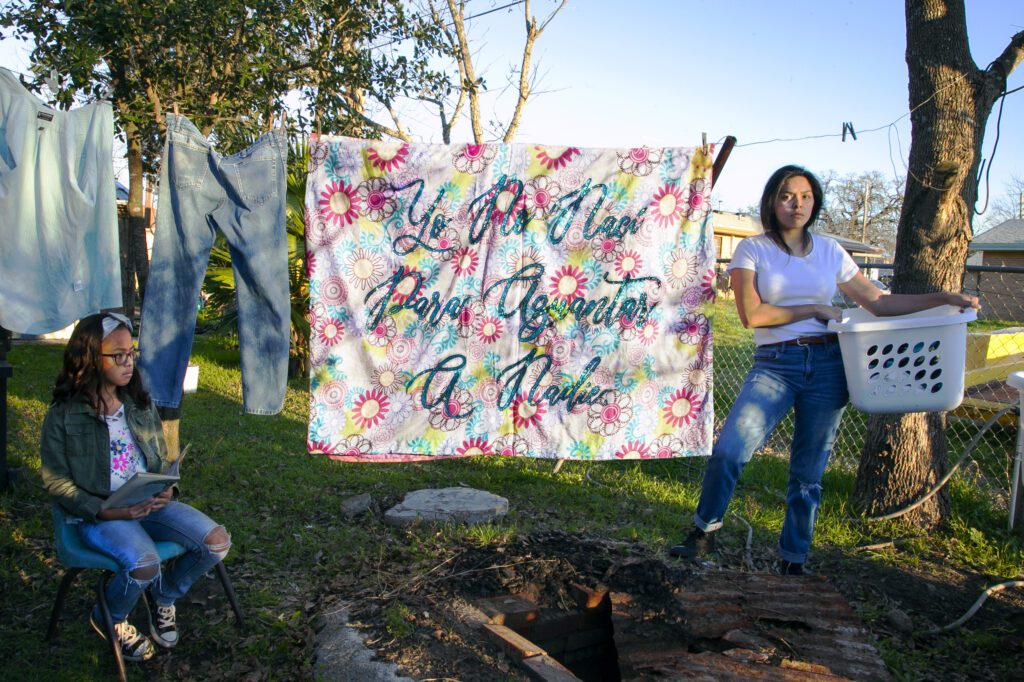
By Darren Jones
The Texan art ecosystem is on the scale of an independent country. The five largest cities of Houston, San Antonio, Dallas, Fort Worth and Austin-ish have distinctive, gently-competitive art scenes; world-class institutions and collections; and a robust commercial gallery sector centered in Houston and Dallas—with its increasingly well-regarded art fair. There’s a constellation of art incubators statewide, from the El Paso Museum of Art to the Galveston Artist Residency. But it’s the lupine enigma of San Antonio, on the sunbaked brink of South Texas, with its disposition of tenacity and nonchalance, that cradles one of the most radical art scenes in America.
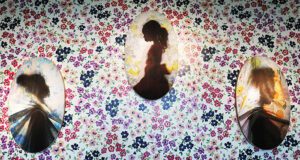
Of the city’s larger institutions, The McNay Art Museum, founded by Marion Koogler McNay, and filled with its namesake’s collection of European and American art from the 19th and 20th centuries, was the first museum of modern art in Texas. Its focus on American art after 1970 continues apace with exhibitions and acquisitions of local artists’ work. Texas-based, Letitia Huckaby’s recently purchased, Koinonia (2021) occupies the atrium. The large-scale, wall-mounted installation comprises floral wallpaper, figurative elements and wooden embroidery hoops, noting themes of community, shelter, domestic and female labor, racial injustice, and generational inheritance. Gossamer portraits of young girls are ghostly remembrances of those killed in the 1963, racist bombing of the 16th St Baptist Church in Birmingham, Alabama. Their dolorous profiles, in oblong frames, evince a quiet, contemplative timbre. The work is both sepulcher and harbinger; memorial and warning.
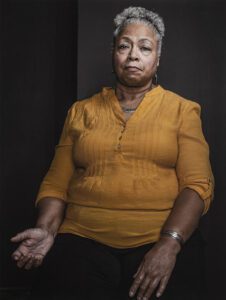
The McNay has also just acquired three photographic portraits by Anthony Francis, that reveal exquisitely layered social commentary by the deft presentation of his subjects’ clothing, gaze, and positioning. There are observations so nuanced that they barely register their presence, but for those who notice them, the pictures will make a persistent impact. It’s there in the upturned hand in Ma, San Antonio, This and-or That, San Antonio, (2019-20) which is almost the position of an arm when having blood drawn; how much of that have Black women in America had stolen from them? Six paintings featuring conchas—Mexican sweet bread rolls—by Eva Marengo Sanchez, are also now in the McNay’s collection; their cracked, ribbed texture is enhanced by warm orange-pink hues, evocative of the light and geology of this region.
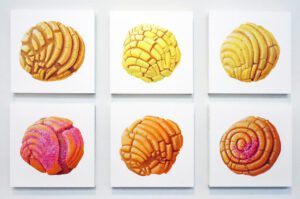
The San Antonio Museum of Art (opened in 1981) occupies what was the Lone Star Brewery complex, and is currently celebrating with “40 Years, 40 Stories: Treasures and New Discoveries from SAMA’s Collection.” Believing that “artists are the lifeblood of a thriving city” the museum’s holdings were recently expanded with acquisitions from nine San Antonio artists. Among them are Joe Harjo, Jenelle Esparza, Jennifer Ling Datchuk and Chris Sauter.

Harjo is a member of the Muscogee Creek Nation of Oklahoma, and works across various media, interlacing tribal lore and culture; white suppression, fetishization, and homogenizing of native people; and the provenance and politics of Americanness as it pertains to race. SAMA bought The Only Chosen Way: Faith (2019) a wall-mounted work in the form of a cross comprised of 24 wooden, triangular flag cases. The glass-fronted displays hold Pendleton beach towels, with tribal designs which are folded to the specification of an American flag when it is given to family members of fallen military personnel. Beginning in the late-1800s, Pendleton established trade agreements with several tribes (the Umatilla, Cayuse, Nez Perce, Walla Walla, Hopi, Zuni, and Navajo nations) to make blankets and shawls in native designs. This, unsurprisingly, expanded into clothing, accessories, home furnishings and, for Harjo, reached an absurd, even humorous nadir with beach towels, which he saw in a Vermont store in 2018. This untrammeled commercial grab diminished the relationship between the tribes and Pendleton, devolving into parody and perpetuating base appropriation.
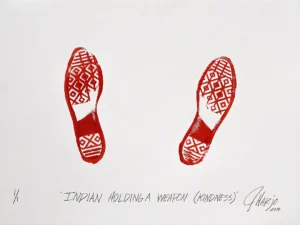
Harjo’s Indian Performance Prints (2012—) is a series of red, ink footprints of the artist—barefoot and shoed—while he was engaged in mundane activities. Titles include Indian Checking Facebook, Indian Taking a Shower, Indian Watching Porn, and Indian Holding a Weapon: COVID-19 Vaccine. It’s an effective and wry piercing of the racist misperceptions about what Native Americans might be doing, when in fact they are participating in shared quotidian experience like everyone else.

Jenelle Esparza was born in Corpus Christie and lives in San Antonio. Her work has an archaeological bent, bound to the South Texan landscape where she investigates personal and manufacturing histories, with a focus on the region’s cotton fields where her family has generational ties. Esparza utilizes natural and mass-produced found objects—sunken logs, rocks, rusted farming implements—textiles, drawing, and installation; but also labor practices associated with the materials, and husbandry traditions. She learned to weave, has worked with cast-bronze, and has waded deep into cotton fields in Banquete, Texas, to photograph—yes, but also to momentarily arrest the flow of life and connect to her heritage through the tendril whispers of her botanical inspiration. By these modes her body becomes an instrument of echo, action and production; a conduit for the wraiths of back-breaking grind whose stories she keeps alive. Her studio, with its loom and books, reflects these compulsions with an atmosphere of both intellectual curiosity and the thrum of physical industry.
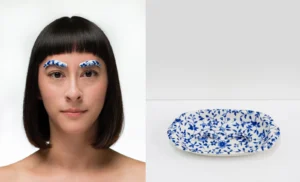
Jennifer Ling Datchuk is of Chinese descent through her mother—if not enough for some when she visits China; and is American, through her father—but not enough for some in this country. She was born in Ohio, raised in Brooklyn, and now lives in San Antonio. Her practice draws on the prejudices, presumptions, and dichotomies of being a first generation Chinese American woman, or “a third culture kid”, not least the dehumanizing question often posed to her, “What are you?” Patriarchal dictates, the commercial exploitation of non-white femininity, and the consequences of idealized beauty hierarchies between East and West are also features of the artist’s work. She utilizes hair, text, porcelain and fabrics in her sculptures, installations and bodily interventions, infusing them with understated wit. Her ideas on these complicated issues are percolated into a searing aesthetic simplicity, exemplified in Pluck (2014) a video wherein the artist removes her eyebrows one by one, as she repeats “he loves me, he loves me not.” It is a profound comment on identity, invisibility, perceptions of foreignness, and the pervasiveness of male judgement on female worth.
Chris Sauter’s studio is a former church, which is a fitting environment for his investigations into the mysteries and oracular possibilities that have bedeviled and obsessed scientists and ecclesiastics for centuries. Biology, astronomy, ritual and doctrine, are principle subjects for his commentary on our attempts to understand selfhood and universali- ty; the terrestrial and the stellar. Signal (2010) is a beautifully pitched example. Rows of prayer candles suffuse a warm glow of spiritual calm, but they are actually blinking out part of a message transmitting data about mankind, sent toward the Messier 13 star system almost fifty years ago, by the recently collapsed Arecibo Telescope in Puerto Rico. The work’s tone, its surprise and subtlety, proceeds from a rare caliber of incisive, uncluttered conceptualism of which Sauter is a master.
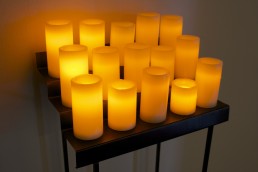
Another of the city’s hubs, Artpace was founded by collector and philanthropist Linda Pace (1945-2007) and is one of the country’s most sought after and generously-funded curatorial and artistic residencies. Each year there are three cycles, when an invited curator selects a Texan, a national, and an international artist for two month stays that culminate in solo exhibitions. That focus strikes a rare geographic equity that has elevated the careers of state artists, while fostering global exchange. The first round of artists in 1995 consisted of Annette Messager (France), Felix Gonzalez-Torres (New York), and San Antonio artist Jesse Amado. Naufus Ramírez-Figueroa (Guatemala), Dan Herschlein (New York), and Shana Hoehn (Texarkana) comprise the most recent trio. A soaring vinyl-text register of past recipients fills a wall two stories high, and makes for an electrifying—and emotional—read through a quarter century of Artpace luminaries.
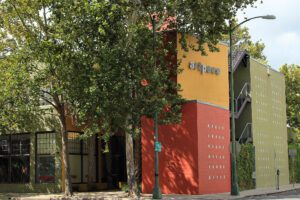
Pace’s support of artists has made her a titanic figure in San Antonio, and this is most keenly felt at Ruby City, the stunning art center that is home to the Linda Pace Foundation which houses, exhibits and loans her collection. Here, famous stalwarts are placed in dialog with San Antonio artists. Ruby City’s Director, Elyse A. Gonzales notes: “we’re in an enviable position in that we are deeply embedded in our local/regional community but also a presence in the larger national and international art worlds. That’s a very exciting aspect of our collection”. This axis is exemplified in the current exhibition “Waking Dreams” which displays works by Christian Marclay, Joyce. J. Scott, and Marina Abramovic among others, alongside Ana Fernandez, Ethel Shipton, Cruz Ortiz and Chuck Ramirez.
San Antonio is home to many more contemporary art and arts organizations, often founded by artists, for artists. They include Cinnabar Gallery; Blue Star Contemporary, a complex of four galleries—San Antonio staple, Flight Gallery is there—artist studios, off-site community spaces, and an international residency that sends four San Antonio area artists to Künstlerhaus Bethanien, in Berlin, for three month stints, each year; the Guadalupe Cultural Arts Center, a supporter and amplifier of Chicano, Chicana and Latinx art for almost forty years; and Sala Diaz, with its Casa Chuck Residency program, founded by Alejandro Diaz in 1995. Its archives were recently acquired by the University of Texas San Antonio. Instituto Cultural de México, is the Mexican Government’s cultural initiative in San Antonio. Recently the institute hosted “Plastic Humanity” (2021) as part of the Luminaria Contemporary Arts Festival, an installation and performance by Nain Leon. He creates digital vignettes, NFTs, photographs, and video, elucidating themes such as environmental catastrophe, the visual sewage and nuclear-egotism of social media, and the irony of computer living that has simultaneously connected and isolated us. At the Mexican Cultural Institute, Leon constructed a tsunami made of single-use water bottles, suspended in stasis just before breaking onto a beach which is littered with garbage. Below the deluge, white-masked performers sunbathe and pose gormlessly, obsessively checking their phones and taking gelfies (glamor-shots), oblivious to the destruction wrought around them. The work’s efficacy is felt when kicking through the incongruous mix of plastic and sand, with the discomfiting knowledge that the refuse Leon has collected is a drop in the ocean of the damage that we’re doing.
Presa House Gallery, was founded by cultural entrepreneurs Rigoberto Luna and Jenelle Esparza. Currently celebrating its fifth year, it has become an extraordinary success as an agitator and elevator of Latinx art, partly due to an expansive network the gallery has forged with art scenes and artists throughout San Antonio’s sphere of influence and beyond, extending as far south as the Rio Grande Valley and Mexico, across Texas, the Southwest, and nationally. A recent exhibition, “Benjamin Muñoz: Rattled Bones“, presented spellbinding monochrome woodcuts featuring towering cornucopias of text and objects relating to the artist’s Mexican heritage and his role as a parent. A newspaper dispenser, a surveillance camera, business signage, skeletal features and calaveras, florals, brand name consumerist products, idioms and delineated background landscapes are among the strata of Muñoz’ visual lexicon.
In December 2021, the gallery presented “South of the Checkpoint / North of the River” which highlighted three artists engaged with the fractures, confluences, identities and romance of the Borderlands; Rigoberto A. González, born in Reynosa Tamaulipas, Mexico, and based in Edinburg, TX; Gina Gwen Palacios, born in Taft, TX, and based in Brownsville; and Donald Jerry Lyles Jr., who was born in and lives in Edinburg. All three artists teach at the University of Texas Rio Grande Valley.
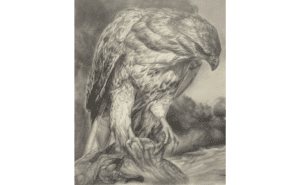
San Antonio has annual and mobile initiatives including the aforementioned Luminaria Contemporary Arts Festival, this year’s Texas Biennial, which several city venues are hosting, and Contemporary Art Month, which takes place each March as a celebration of San Antonio’s art scene and artists.
José Villalobos is increasingly prominent in San Antonio and nationally, and is among the most valorous and arresting artists of his generation. He was raised in El Paso on the US-Mexico border in a conservative, Evangelical Christian home, and was subject to the homophobic mores and contradictions of society generally, and Norteño culture specifically. For example, while the flamboyant stage attire that revered Norteño musicians would wear on television or stage was an accepted part of their art, someone wearing the same clothing on the street would likely elicit homophobic abuse and degradation. Meeting, rejecting and reconciling aspects of such sociological and religious schisms underpins Villalobos’ practice which incorporates installation, performance and sculptural objects.
The artist intercepts the oppressive connotations of Western and Mexican acute-masculinity (drag in and of itself) and remilitarizes them in the aesthetics of sovereign-queerdom such as a bejewelled silver saddle; cowboy hats adorned with tassels and sequins; and a phantom steed, traced in the air by a horse pack and burdened with luggage—an equine standard-bearer carrying the Pride Flag. Text is also employed to skewer the violence in vernacular slurs, exemplified in Villolobos’ 2019 exhibition “Joto Fronterizo | Border Faggot” (Freedman Gallery, Albright College, PA) and in “De la Misma Piel” (2016, Guadalupe Cultural Arts Center), which included belts carved with ‘sodomita’, ‘maricón’ or ‘jotito’. With transcendent and poetic grandeur, there are heraldic, ceramic wings, shown in “Fragmentos y Suturas”, (2019, South Texas College, McAllen), fired and stained to look like stitched leather—the ascension of a resplendent gay phoenix on the farthest edges of Texas.
Also tightening the straps on cultural persecution, is Louisiana-born, Heyd Fontenot, a long-time Texas-based artist now living in San Antonio. His work is often concerned with the moralizing hypocrisy of organized religion, and how it’s used to vilify queer people. His 2018 multi-media inhabited-installation, “The Temptation of Saint Reborlaro” (titled after charlatan televangelist, Oral Roberts—spelled backwards) was exhibited at Living Arts, Tulsa, Oklahoma. Fontenot’s sensitivity to the complexities of fear and psychological harm lend his work equilibrium between the compulsion to unnerve religious aggressors and offer succor to those traumatized by their doctrinal shaming.

That project in particular touches on the kind of depravities of man that are so severe they can corrupt the very atmosphere of a place, almost leaving an invisible rip in nature. Roberts’ City of Faith Hospital and Oral Roberts University complex, just outside Tulsa, is just such an unnatural vortex. The air of this pantheon to Defcon 1 egotism reeks of the wickedness, lies and fraud that built it. The impact that Roberts’ demonizing has had on the suicides, killings and abuse of gay people in America and globally, cannot be understated. Happily, Roberts is no longer with us, having returned to sit for eternity at the side of his beloved maker—and he’s not in Heaven. But the stench of his presence remains. Today, his university is one of the most LGBTQIA+-phobic universities in America. The website states that: ‘At ORU, we pledge not to engage in or attempt to engage in any illicit, or unscriptural sexual acts, which includes any homosexual activity…’. Intriguingly, “unscriptural” can be anagrammatized to read “lunatics purr”.
Talking of, there are other bearers of Roberts’ baleful torch, which makes frontline cultural warriors of Fontenot’s ability, essential. There is moral bankruptcy defined—formerly known as mewling bigot, Jerry Falwell Jr; feral, porcine “pastor” Donnie Romero, who praised the Pulse gay nightclub massacre, in Orlando, and wished the body count had been higher; and the crepuscular, Marion “Pat” Robertson, an oxygen-thieving zealot who, despite appearing deader than Grandpa Sawyer in The Texas Chainsaw Massacre, still wheezes through his duties as a host of the Christian Broadcasting Network’s “700 Club”.
Fontenot is a nimble thinker; he clothes his anger and mockery of religious extremism in just enough whimsy—bunting, animals, song, costumes, ritualistic props, film, performance, and playful nude drawings of Renaissance opulence à la Botticelli—lest this most genial of artists seem unwelcoming or morose, despite the suffering he seeks to assuage. But his commitment to countering biblical terrorism, is deadly serious. Incidentally, Robertson said of this writer’s birth country, “Homosexuals are riding high in the media … And in Scotland, you can’t believe how strong the homosexuals are.” agus na dìochuimhnich e!
The gendered demands placed on Gabi Magaly during her Mexican-American upbringing are the font of her photographically-oriented practice, which she describes unflinchingly: “My childhood was saturated with the machismo and marianismo culture. Hypermasculinity oozes brutality, control, and bad cologne. Placated and tongue-biting women don’t speak up, act up, and always have rice and tortillas on the table at precisely six o’clock. Daughters are raised to submit to men, are being taught to fetishize purity and holiness. We are expected to feed stomachs, ego, and a taste for violence.”
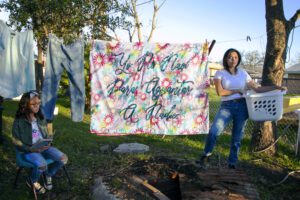
But this was not for Magaly. Her subverting of her predestiny, and the emancipation she has gained are hard-won yet ever under threat from the stubborn bedrock of established societal roles. It’s a circumstance made more difficult by recent anti-women laws in Texas (and elsewhere) that had the backing of the state’s maniacal governor. Art is the vehicle that she rams into the patriarchal edifice that would otherwise have consumed her. While her father evinced the traditions of female compliance—deference, domesticity, child-bearing—her mother cautioned her to attain autonomy and self-fulfillment. Magaly is an invigorating cultural mutineer, bracing and unrepentant in her determination to break bonds not just for herself, but for other women. Yet her emotional intelligence lends her the self-awareness to incorporate inevitable moments of reflection, exhaustion and doubt.
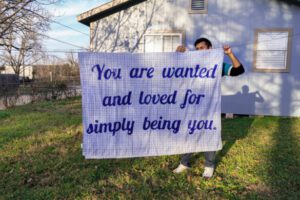
That acknowledgment of vulnerability strengthens the work, and provides further relatability to those who have experienced what she is voicing. She utilizes photography, homely items of feminine labor, embroidery, text and installation. Whether pastel-pretty greetings cards with alternative messaging—“Por favor hija, no seas pendeja” (please daughter, don’t be dumb); a prayer to Saint Monica that Magaly has amended, switching a woman’s hope for strength to bear her husband’s infidelity, for a promise to divorce him; intimate photographs taken with her partner during or after scorching arguments; or a delicate, floral doily embroidered with a clitoris; Magaly torpedoes the wholesomeness and submission demanded by generational and familial rites, returns the viewer’s gaze with interest, and hands the patriarchy’s shrunken balls back to it on a silver platter.
Female form and its politicization—what it is to be, and to be in possession of one’s identity as a woman—are also fundamental to Joey Fauerso, who is known for her large-scale, black and white works that both highlight and dissolve distinctions between abstraction and figuration, organic and geometric, nature and manufacture. More personally, she incorporates what it is to be a mother and a creative worker, to be at home and in the studio. Fauerso combines sculpture, drawing and performance, not only collapsing their definitions—sometimes literally—but so intrinsically that they become one harmonious action. This almost simultaneous construction and disassembly is a flux noted by Fauerso when she writes that: “I read somewhere that a spider sometimes eats her web to replenish her supply of silk.”
In Thomas Harris’ book Red Dragon, the serial killer, Francis Dolarhyde consumes William Blake’s watercolor, The Great Red Dragon and the Woman Clothed with the Sun. This is too dark a reference to apply to Fauerso’s interests or oeuvre, but that sense of constant transformation, of quickening and vanishing, and of rebirth are intrinsic to her process. There is also keen and delightful wit. A video piece titled The Clearing (2010) is set in an arcadian, woodland glade, rendered in watery greens and browns. Flights of birds sail overhead, and a flautist—the artist—Pied Piper-like, serenades us. It is souped-up Thomas Kinkade, if his pastoral world-building were animated. That is, until a young, naked man dances on-screen, gawps around in wonderment, spinning, toppling, and falling, before getting up and sauntering off into the trees. You won’t see that in one of those twee Jacquie Lawson video ecards that well-meaning relatives oblige you to spend interminable minutes watching.
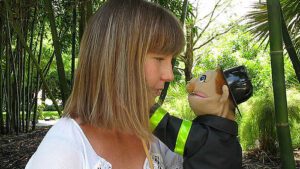
Fernando Andrade was born in Acuña Coahuila, and moved to the United States when he was seven. Now based in San Antonio, his consummate drawings of gnarled sticks from his series Palos y Piedras (sticks and stones) (2013/14) and God Bless America (2015) recall the childhood war games he’d play with his friends and cousins growing up in Mexico, using rocks as grenades and sticks as guns. The drawings carry subtly debossed text advertisements from firearms magazines. Today youngsters where Andrade was raised use real firearms, given to them by cartels to carry out crimes, for which the courts will treat them more leniently if they are caught. Andrade draws a single wooden “gun” on the page, focusing the viewer’s attention on the sinuous, natural lines, and similarity to real weaponry.
The works ruminate on the consequences of abducted freedoms, and the language and ammunitions of pretend and actual violence, intensified by the immensely accomplished draughtsmanship and restrained compositions. For all the rudimentariness of Andrade’s long-ago wooden pistols, his drawings of them have the futuristic cool of science-fiction weapons by H. R. Giger, or the Gristle Gun in David Cronenberg’s eXistenZ, reminding us that innocence is always at risk of being superseded by the warped fantasies, cynicism and greed of adulthood.
Also committed to familial history, Ruben Luna constructs portable cases containing artifacts and ritual objects of familial love and caring, each one dedicated to a relative. His emotionally charged collections are intended as a celebration and archiving of blood and genealogical bonds. In Portrait of My Abuelita (Grandmother), a red interior is moulded to fit various items, including a broom used by Luna’s grandmother during “limpia”, a spiritual cleansing wherein Luna would lay down, and she would sweep negative energy from his body. There is also a can of 7-UP, for upset stomachs, and VapoRub, applied for minor ailments.
The collections can be considered sacraments, at once specific to Luna’s lineage, yet transferable to viewers who fondly remember family traditions in their own pasts. At Luna’s studio, this writer, recalled his grandmother’s liberal application of Scotch for any infirmity, albeit with dubious scientific reasoning—a common treatment in working-class Scotland that possibly created a host of eight-year-old alcoholics.

San Antonio may not spring to mind as a conductor for contemporary art, and it does lack a collector base that would support more commercial galleries—although Ruiz-Healy Art, focusing on Latinx, Latin American and Texan artists (and with a space on New York’s Upper East Side) is a very impressive exception. San Antonio’s scene has a rangy feel, and if it lopes around the periphery of the American contemporary art world, often unnoticed, and perhaps even licking its lips at the kills of its brasher neighbors, Dallas and Houston—it seems unhurried to join the fray. It can live with some hunger because there is a placeness here that gives a sense of self-possession.
San Antonio’s artists are its scene, with Nate Cassie, Raul Rene Gonzalez, Hiromi Stringer, Sarah Fox, and Angelica Raquel among many who warrant further attention. The synthesis between artists and civic and art institutions is a pillar of the city’s creative momentum. Many artists work in, or have shown in city museums, and are involved in the substantial practice of collaboration and artist-run spaces which underpin organizational sensibilities. While there are hierarchies in any network, there is a conviviality among curators, artists, directors, writers, board members, dealers, and teachers, which plays out informally during fire-pit conversations at exhibition openings, off-peak gallery visits, or mid-week installs. There’s an unpretentious, homey localism, yet it is the seventh largest city in America and has attained due international kudos through lean and agile cultural exchange programs like Artpace. There is a stable cadre of local artists, but there are always incoming voices, so that everyone knows almost everyone, preventing stagnation.
There is something else that secures San Antonio’s authenticity. Location can ignite, or deaden art’s effect. When art that is about a place—the stories, myths, traumas, politics and hopes of particular landscapes, and when it is seen, mulled and discussed there, where the seams of human experience have settled, art can reach its fullest realization.
Seeing these artists’ work, in the environments that informed it, under the cultural storms that affect it, and traveling through terrain, beneath the skies and vistas, from which it still grows, brings contextual understanding of its origins and social urgency. It is not something that an audience can experience taking the L train from Brooklyn to Chelsea, to see the work, strong as it is, but transplanted from the soil that nourished it, to a bland, white gallery. In liberal bastions like New York where so much has been achieved, so many battles won, all artistic discourse is embraced. Audiences are so well-versed and accepting that their is little friction with art’s messaging. The majority of cosmopolitan populations in most major art centers are in political agreement with what an artist may be saying. As vital—and so far unresolved—as it is for regional and marginalized artists to be included in the greatest American museums, and to be seen internationally, it is also incumbent on audiences who really want to know the roots of an artist’s reasoning to come and see the work where it originates.
When Jenelle Esparza explores the cotton fields of her forbearers’ toil; Gabi Magaly returns to her grandmother’s home in San Luis Potosi, Mexico, after an absence of fourteen years, to recover the value of her kindred history; José Villalobos assails the prejudices of his upbringing; when Heyd Fontenot reflects the murderous antics of religious criminals upon congregants’ faces; or when Fernando Andrade reaches into his past, to draw the machinery of future violence; they are doing so fully immersed in what has been lived, what is fading, or yet needs to be challenged. Such qualities place these artists and their peers in South Texas and elsewhere in the state, at the forefront of artistic activism in America.
Each of their voices, histories and geographies—literal and cultural—have joined within their practices, in an equation of supple artistry. They are insisting on the eminence of subjects in a state—a country—whose populations and governance may not want to hear them, and are often politically and religiously averse to evolution and inclusivity or to losing their grip on power. This is what moves these artists’ work beyond art-making, and into creative munition—motives for change where it most needs to happen.
In San Antonio, throughout South Texas and along the border, artists are working in the most fraught and abused arena in America, the scene of brutalities, and inhumanities that stain the hands of craven politicians on both ends of the ideological spectrum, by their use of the border as a political tool, where before, there was uninterrupted life and nature. In an endless cultural seiche, these landscapes have been Mexico, Texas and the United States (wherever today’s borders may lie) with America often playing the fumbling, prickly role in an uncommon threesome prone to furtive spurts of dissatisfying intervention.
There was never a single frontier (as Hollywood’s ridiculous prejudices would have us believe), but many—there still are. These are the crucibles where art has the most work to do, to engage (or enrage) audiences, and when artists commit to these locations they form a potent, networked discourse. San Antonio and South Texas are a center of contemporary art production made vital by the stresses and legacies of the region’s roiling sociological fault-lines. It is the artists working here, who are keeping their balance and focus among these buckling tectonic uncertainties and progressing despite them, that are among the most significant critical voices in American art.
Darren Jones is a Scottish-American art critic. He is the US editor-at-large for New Art Examiner, and a frequent contributor to Artforum. He is the recipient of an Andy Warhol/Creative Capital Arts Writers Grant. Darren teaches Curatorial Practice at the Maryland Institute College of Art, in Baltimore.

